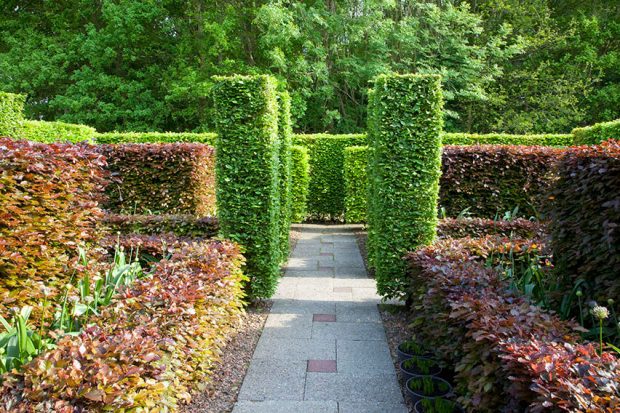When Does Copper Beech Come Into Leaf?
A copper beech hedge is a beautiful sight to behold in your garden! More showy than the native common beech, these purple beech trees can be grown as standalone trees or full hedges. Fagus sylvatica purpurea is an ornamental cultivar, which means it’s all about those beautiful leaves.
But those leaves don’t stay fresh all year round.
Find out when the copper beech will grow leaves, shed leaves, and what colours to expect in our full guide here.
Find out more on Copper Beech hedging here.


Copper Beech Hedge Appearance
Copper beech hedge, Fagus sylvatica purpurea, likes well-drained soil and partial shade. Did you know that the copper beech hedge is the same tree, just pruned into a hedge shape?
Copper Beech Leaves
Copper beech trees come into leaf in the spring, usually the last weeks of April. Their young leaves will unfurl from buds and immediately become a distinctive colour – deep purple. The foliage is made of smooth, oval-shape leaves that are occasionally eaten by our native caterpillars in England.
During autumn, the leaves will turn copper brown along with the other shrubs and trees in your garden. Copper beech tends to hang onto it’s leaves, however, so they may still be dropping throughout winter.
Flowers
Copper beech hedge will have both male and female flowers grow amidst the foliage, which are usually pollinated by the wind rather than wildlife. They are small and green in colour, blending in among the plants.
In the summer, beech plants can produce beechnuts – but these are best left as bird food rather than harvested, although they are edible.
Size and Spread
Copper beech trees can grow up to 100 feet tall, but most garden trees are trimmed yearly to keep them shorter and prevent excess growth.
The distinctive foliage of the beech hedge plant hides the impressive branches beneath. Although hardy and suitable for most soil types (especially chalk), the trunk can actually be quite sensitive. The light grey bark can react negatively to excessive sunshine, so keep it in a partially shaded location and go easy when pruning, so the foliage can shelter the branches beneath.
Did you know that beech wood can be made into furniture?
Pests and Diseases
Fagus sylvatica – including copper beeches and other beech varieties – are susceptible to a range of fungus infections, pests and diseases. The most common are:
- Root rot – usually happens when the ground is not well-draining or becomes waterlogged.
- Bark stripping – grey squirrels are usually the culprit. Most beech plants will survive this, however.
- Beech bark disease – a disease native to beech trees, caused by severe infestations of fungus or scale insect.
If one of your beech plants is compromised, try to isolate the site. If it’s part of a larger hedge, you’ll want to remove that plant and the next few plants along. Don’t compost what you remove either!
To prevent the fungal disease or pests from spreading, disinfect all your equipment (including the tool handles) and burn any infected plants.
Beech Trees, Live at Gardeners Dream
Copper beech trees are beautiful. Our range of deep purple plants are almost as popular as our common beech plants! From spring through to autumn, they are wonderful deciduous additions to your garden.
We hope that this guide has helped you understand when copper beech comes into leaf, and more about these interesting trees.
Quickfire FAQs
What month do beech hedges turn green?
Common beech has naturally green foliage. Once planted, a common beech hedge should be green from spring through to autumn rather than year round (it’s deciduous, not evergreen). Other beech plants are not typically green, but may change colour if planted in the shade.
How long does a copper beech take to grow?
Growing up to 1 metre per year, it can take 15 years for copper beeches to reach full height. If you grow this plant as a hedge or choose a dwarf variety, pruning the branches can keep it at half this height or less. Read the product descriptions at Gardeners Dream for more details about growing heights and spreads.
What does a beech tree look like in spring?
In early spring the wood bark and branches will still be visible, as the new buds begin to flourish. By late spring, the foliage will be full developed and either green or purple depending on the beech variety you’re growing.
Do copper beech trees go green?
Copper beech trees (or a beech hedge) usually have purple leaves. However, the leaves can turn green if the specimen is planted in the shade in your garden. Leaves turning green is a sign of too little light.
Is copper beech fast growing?
Both common beech and copper beech trees can grow 1 to 2 feet per year in the UK, starting in the spring. Native to our country, they thrive in our climate and show steady growth once planted.
How tall do copper beech trees grow?
In England, high-quality, healthy beech trees can grow up to 100 feet tall but most stop somewhere between 50 and 75 feet. You can prune the tree to keep it shorter.
What is the lifespan of a copper beech tree?
The copper beech can live for 150 to 200 years, which is quite long in the plant world but short in the tree world. The right conditions in combination with some good luck can see the copper beech live for over 300 years!
Is copper beech good for wildlife?
Yes! Common beech is native to the UK and Copper Beech holds many of the same characteristics. The leaves are food for insects and the nuts can support birds, squirrels and other native wildlife too.